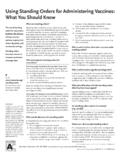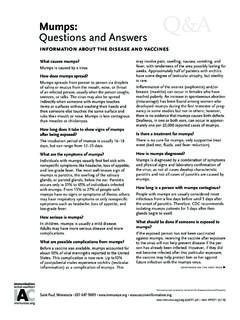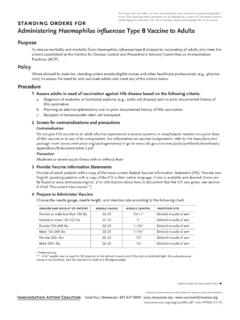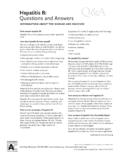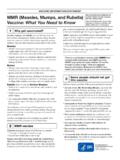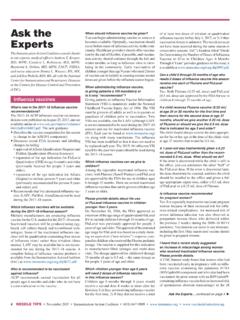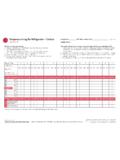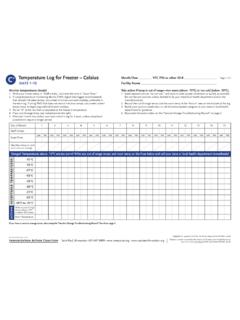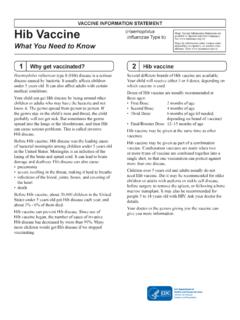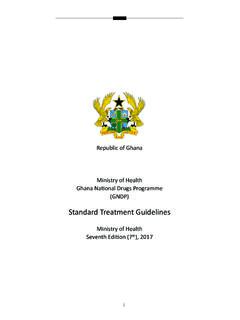Transcription of Standing Orders for Administering Pneumococcal Vaccines ...
1 Standing Orders for Administering Pneumococcal Vaccines (PPSV23 and PCV13) to AdultsPurposeTo reduce morbidity and mortality from Pneumococcal disease by vaccinating all adults who meet the criteria established by the Centers for disease Control and Prevention s Advisory Committee on Immunization allowed by state law, Standing Orders enable eligible nurses and other healthcare professionals ( , pharmacists) to assess the need for vaccination and to vaccinate adults who meet any of the criteria Assess Adults for Need of Vaccination against Streptococcus pneumoniae (pneumococcus) infection according to the following criteria:Routine Pneumococcal VaccinationThe information that follows is adapted from ACIP recommen-dations on Pneumococcal Vaccines (MMWR, Nov.)
2 22, 2019) available at Pneumococcal polysaccharide vaccine (PPSV23, Pneumovax) is recommended for all adults age 65 years and older. Pneumococcal conjugate vaccine (PCV13, Prevnar) is no longer routinely recommended for all adults 65 years and older. Instead, shared clinical decision-making (SCDM) for PCV13 use is recommended for people age 65 years and older. (See Table 1 on page 2 for PCV13 risk-based recommendations). CDC guidance for shared clinical decision-making between patients and providers. Considerations for SCDM may include the individual patient s risk for exposure to PCV13 serotypes and the risk for Pneumococcal disease for that person as a result of underlying medical conditions (For details, see gray box at right).
3 Scheduling when PCV13 is to be administered. If a decision to administer PCV13 is made, it should be administered before PPSV23 (see information Table 1, footnotes 2 and 3). PCV13 and PPSV23 should not be administered at the same visit. The recommended intervals between Pneumococcal Vaccines is 1 year for adults age 65 years and older without an immunocom-promising condition, CSF leak, or cochlear implant, regardless of the order in which the Vaccines were received. (For adults with immunocompromising conditions, CSF leak, or cochlear implant, see risk-based recommendations in the next section. See Table 1.) Standing Orders for other Vaccines are available at : This Standing Orders template may be adapted per a practice s discretion without obtaining permission from IAC.
4 As a courtesy, please acknowledge IAC as its source. Immunization Action Coalition Saint Paul, Minnesota 651-6 47-9009 Item #P3075 (2/20)continued on the next page PCV13 is a safe and effective vaccine for older adults. The risk for PCV13-type disease among adults age 65 years and older is much lower than it was before the pediatric program was implemented, as a result of indirect PCV13 effects (by preventing carriage and, thereby, transmission of PCV13-type strains). The remaining risk is a function of each individual patient s risk for exposure to PCV13 serotypes and the influ-ence of underlying medical conditions on the patient s risk for developing Pneumococcal disease if exposure occurs.
5 The following adults ages 65 years and older are potentially at increased risk for exposure to PCV13 serotypes and might attain higher than average benefit from PCV13 vaccination, and providers/practices caring for many patients in these groups may consider regularly offering PCV13 to their patients age 65 years and older who have not previously received PCV13. Persons residing in nursing homes or other long-term care facilities Persons residing in settings with low pediatric PCV13 uptake Persons traveling to settings with no pediatric PCV13 programIncidence of PCV13-type invasive Pneumococcal disease and pneumonia increases with increasing age and is higher among persons with chronic heart, lung, or liver disease , diabetes, or alcoholism, and those who smoke cigarettes or who have more than one chronic medical condition.
6 Although indirect effects from pediatric PCV13 use were documented for these groups of adults and were comparable to those observed among healthy adults, the residual PCV13-type disease burden remains higher in these groups. Providers/practices caring for patients with these medical conditions may consider offering PCV13 to such patients who are age 65 years and older and who have not previously received : for Shared Clinical Decision-Making Regarding Use of 13-valent PCV13 in Adults Age 65 Years and OlderRisk-Based Pneumococcal Vaccination Use the risk-based vaccination guidance described below in Table 1 for people age 19 years or older with an under-lying medical condition or other risk 1.
7 Risk-based vaccination for adults age 19 years and oldercategory of underlying medical condition or other risk factor recommended Vaccines are marked x below. PCV13: 1 dose1 PPSV23: 1 dose2 PPSV23 booster2,3 Non-immunocompromisingChronic heart disease4, chronic lung disease5xDiabetes mellitusxChronic liver disease , cirrhosisxCigarette smokingxAlcoholismxCochlear implant, cerebrospinal fluid (CSF) leakxxImmunocompromisingSickle cell disease , other hemoglobinopathyxxxCongenital or acquired aspleniaxxxCongenital or acquired immunodeficiency,6 HIVxxxChronic renal failure, nephrotic syndromexxxLeukemia, lymphomaxxxGeneralized malignancy, Hodgkin diseasexxxIatrogenic immunosuppression7xxxSolid organ transplant, multiple myelomaxxxfootnotes 2 Screen for Contraindications and PrecautionsContraindications Do not give Pneumococcal vaccine (PPSV23 or PCV13)
8 To a person who has experienced a serious systemic or anaphylactic reaction to a prior dose of the vaccine or to any of its components. For a list of vaccine components, refer to the manufacturer s package insert ( ) or go to pinkbook/downloads/appendices/ Precautions Moderate or severe acute illness with or without fever3 Provide Vaccine Information StatementsProvide all patients with a copy of the most current federal Vaccine Information Statement (VIS). Provide non- English speaking patients with a copy of the VIS in their native language, if one is available and desired; these can be found at (For information about how to document that the VIS was given, see section 6 titled Document Vaccination.)
9 Immunization Action Coalition Saint Paul, Minnesota 651-6 47-9009 Item #P3075 (2/20) Standing Orders for Administering Pneumococcal Vaccines to Adults (continued) page 2 of 5continued on the next page 1. PCV13 is recommended as a one-time dose among persons in a risk group not previously vaccinated with PCV13. 2. Administer PPSV23 unless PCV13 is also needed. In that case, give PCV13 first fol-lowed by PPSV23 at least 8 weeks later. If PPSV23 was previously given, administer PCV13 at least 1 year after Give a second PPSV 23 at least 5 years after the first PPSV23 and at least 8 weeks after PCV13. However, for adults age 65 years and older, give only one dose of Chronic heart disease includes conges-tive heart failure and cardiomyopathies; excludes Chronic lung disease includes chronic obstructive pulmonary disease , emphy-sema, and Congenital or acquired immunodeficiency includes B- (humoral) or T-lymphocyte deficiency, complement deficiencies (par-ticularly C1, C2, C3, and C4 deficiencies), and phagocytic disorders (excluding chronic granulomatous disease ).
10 7. Iatrogenic immunosuppression includes diseases requiring treatment with immu-nosuppressive drugs, including long-term systemic corticosteroids, and radiation Prepare to Administer VaccinePPSV23 may be administered either intramuscularly (IM) or subcutaneously (Subcut). PCV13 must be given IM. For vaccine that is to be administered IM, choose the needle gauge, needle length, and injection site according to the following chart:gender and weight of patientneedle gaugeneedle lengthinjection siteFemale or male less than 130 lbs22 25 "* 1"Deltoid muscle of armFemale or male 130 152 lbs22 251"Deltoid muscle of armFemale 153 200 lbs22 251 1 "Deltoid muscle of armMale 153 260 lbs22 251 1 Deltoid muscle of armFemale 200+ lbs22 251 Deltoid muscle of armMale 260+ lbs22 251 Deltoid muscle of arm* A " needle may be used in patients weighing less than 130 lbs (<60 kg)
